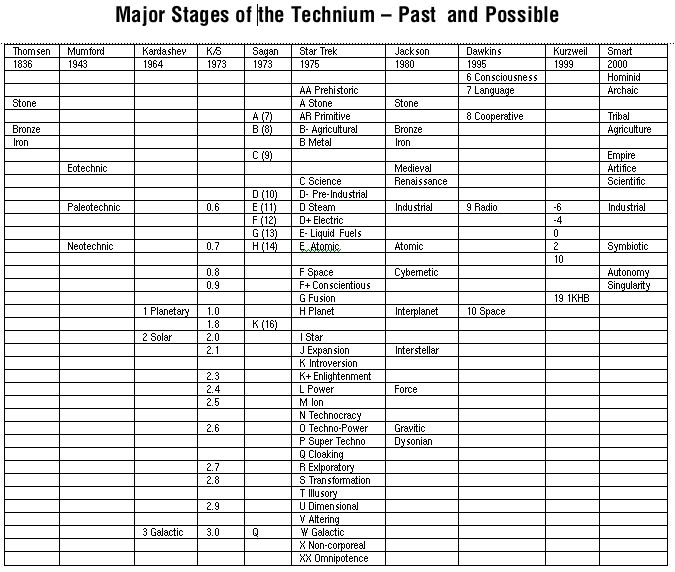Major Stages of the Technium
Biological life plays out in stages. Although our lives are continuous, we recognize certain thresholds that we pass through as human beings. We might designate the stages of human life as proceeding from a fetus to infant to toddler to child to adolescent to adult. Each developmental phase is marked by certain quantifiable patterns. Children are small, their heads large in proportion to their body, their hormones and organs hover at a certain level. These proportions will shift significantly when they reach they next phase of development at about 12-15 years.
No individual exhibits growth in exactly the same way. However the general trajectory of development will be similar no matter what we care to measure. In every meaningful classification of human development, the infant will precede the codger.
I suggest that civilizations follow the same patterned development. If we were able to survey galactic civilizations, we would of course find a tremendous variety, but also a range of advancement. Some planets would shock us by their unexpected societies, much as we are astounded by the life cycles of peculiar organisms on earth. But just as the development pathways of ferns, whales, mushrooms, and butterflies differ wildly, they share a common set of stages in their taxonomic realm – such as seed/spore/egg. Individual civilizations will exhibit growth in their own distinctive way, yet the large-scale trajectory of development might be shared.

If we viewed the technium – the whole adaptive system of technology and culture — as a planetary-scale organism, we can categorize its short history into stages. A few brave historians have classified past epochs of humanity, almost as if these grand eras were geological periods. I say brave because it there are few ways to test this classification and nothing but trouble for attempting these distinctions. What is to prevent the classification from being totally arbitrary? On the other hand there very well might be certain inherent dynamics constraining any society, which would generate similar thresholds – similarities that would only be apparent if we have a sample larger than the one we have.
I decided to examine as many large-scale classifications of societal development as I could in order to see if, in aggregate, an agreement across independent charts would reveal a larger pattern of stages. Perhaps dissimilar views might perceive similarities.
However while I was curious about the past, my chief interest in this exercise is to imagine what the future stages of societal development would likely be. Framing the past developmental epochs of planetary society might point to future stages. Since this is outright speculation I felt comfortable ransacking science fiction for suggestions as well. I acknowledge that the premise I am working on — that there is a single convergent evolution among civilizations — could be laughably wrong. But I find it useful to two reasons. First, in the total absence of other evidence, it is still the simplest hypothesis. Second, I am more persuaded than most people of the evidence for convergent evolution in biology and in theories of exo-biology, and so I find the prospect of convergent evolution in societies plausible.
I uncovered ten schemas (sources below) charting past stages of humanity or possible future stages of galactic civilizations. All the schemas are very one-dimensional – measuring one or a few qualities in a ranking scale. Matrixes capable of mapping society types in multi-dimensions are rare, even in historical research. Robert Carneiro’s work is an exception in academia, and very controversial. The most robust multi-axis space of possible civilizations that I’ve come across is one created as a world-creation tool kit for role playing games: The Cosmic Creation Netbook. (If I have missed any, please email me or post in the comments.)
I combined these ten schemas into one chart and correlated (as best I could) their stages.

Sources:
Christian Thomsen, Ledetraad til Nordisk Oldkyndighed, 1836.
Lewis Mumford, Technics and Civilization, 1934, p. 109.
Nickolia Kardashev, Transmission of Information by Extraterrestrial Civilizations, Vol.8, No.2, Soviet Astronomy – AJ, Sept-Oct. 1964. p.217-221.
K/S: Carl Sagan, Cosmic Connection: An Extraterrestrial Perspective, 1973. p.234-238.
Carl Sagan, Cosmic Connection: An Extraterrestrial Perspective, 1973. p.233-234.
Star Trek, Richter Scale of Cultural Development. A fictional taxonomy the crew of the Enterprise use to classifies civilizations it encounters.
Steven Jackson and William Barton, GURPS, Space, 3rd Edition, 2002. p. 26. This system is devised to aid role-playing gamers to devise game worlds.
Richard Dawkins, River Out of Eden, 1995, p. 151-161. Dawkin’s metrics are the levels of replication organization, starting with molecular replication and continuing to the level of planetary civilizations replicating.
Ray Kurzweil, Kurzweil uses an exponential notation for the advance of computing power, He also suggests the benchmark of a computer equal to 1,000 human brains, which I have abbreviated as 1KHB.
John Smart, The Developmental Spiral . Smart suggests each phase occurs in half the duration as the previous, forming the picture of a spiral closing in on itself to the point where it stops being measurable – the Singularity.
Several patterns emerge. First, the classification schemes have evolved over time. The earliest ones rank civilizations by their use of materials (stone, brass, iron), the later ones rank by a society’s use of energy, and most recently the schemes rank by the civilization’s control of information. This drift in ranking criteria mirrors the general drift in what we find most important, and most challenging. The crucial ask of early civilizations was to organize and control matter; later it was to organize and control energy, and now it is to organize and control information. (Of course, I’ve just introduced yet another schema for society types, one ranked by their central organizing challenge!) If we had any idea of what the crucial challenge in a hundred years from now would be, we could bet that their ranking would use that focus.
Second: In the speculations about the future levels of civilizations we have no trouble imagining new degrees of control of both matter and energy. When the Star Trek scale of cultural development labels a planet system as a “Type M civilization” it is categorizing its mastery of energy and matter. The ingenious Kardashev classification system likewise labels societies according to their ability to control all the energy contained on their planet, star, or galaxy. What’s missing are detailed speculations on possible levels of cognition, information organization, or mind. The prospect of a singularity scares off speculation beyond that.
My hunch is that the next stage in our civilization will revolve around the challenge of controlling and organizing minds. We’ll have our own enhanced minds soon, the minds of personal AIs, the global mind of all our minds connected, and a global AI – just to start. Fifty years from now the chart of the Major Stages of the Technium will have new columns of speculations, and these levels of civilizations – both historical and future — will revolve around types of intelligences.


